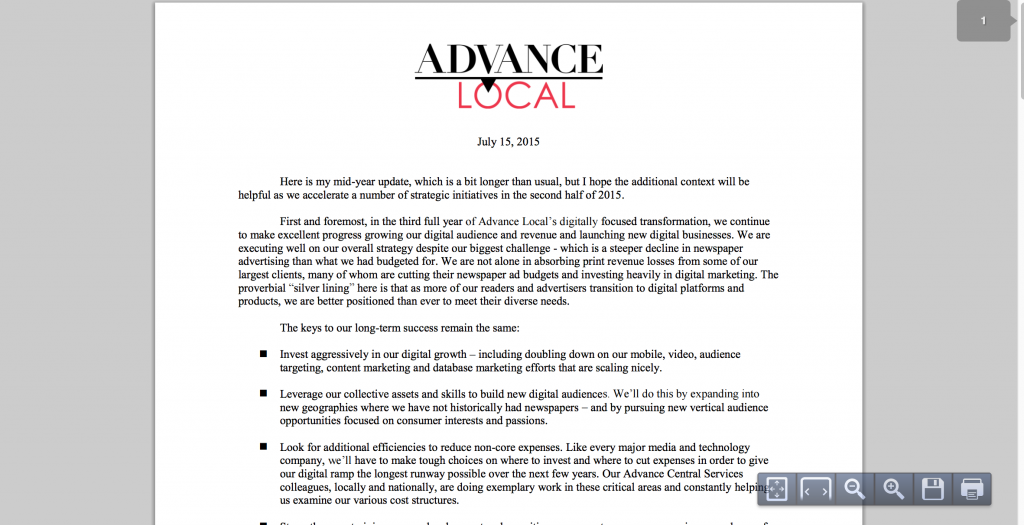As Advance publications began dropping print frequency and betting its newspapers’ future on digital ad sales five years ago, part of the premise was that print advertising would only continue to decline — and by a lot, not a little.
Correct. But the industry’s particularly nasty level of print losses in the first half of 2015 have nipped financial results at Advance along with the rest. In his latest biannual letter to employees, Advance Local President Randy Siegel backed off his claim of six months ago that digital ad gains this year will surpass print losses.
He concedes in the letter that newspaper declines have been “steeper than we budgeted for.” Siegel told me in a phone interview that the goal for growing ad revenue overall remains and some of Advance’s 25 markets will experience the revenue crossover, but added “I can’t guarantee that we will get it done in all of them.”
In the letter, dated July 15, Siegel continues:
The proverbial “silver lining” here is that as more of our readers and advertisers transition to digital platforms and products, we are better positioned than ever to meet their diverse needs.
But the letter, mostly upbeat in highlighting digital audience gains and noteworthy journalism, also dishes a little tough love to the sales force:
We still have a long way to go. Our local sales teams need to get more comfortable asking for and ultimately selling larger digital packages to prospects of all sizes. Our business-to-business sales initiatives, while growing well in terms of year-over-year percentage growth, are a fraction of what they should be. While our mobile and video ad revenue gains have also been stellar in terms of year-over-year percentage growth, they should be increasing at a much faster rate given our level of investment.
The mixed report raises a more general question. Many companies including Gannett, McClatchy, Journal Media and The New York Times, for that matter, have started big programs this year to accelerate the newsroom culture change from ingrained print-first habits and to launch new digital products faster.
By virtue of its earlier start, is Advance ahead of the game?
Unfortunately the Newhouse family’s privately held company doesn’t provide any of the revenue or profit numbers that would provide a credible financial/business model answer.
Still, the equation remains pretty much the same as when I (and similarly Ken Doctor) analyzed it in 2012 when the new strategy came to New Orleans and sparked intense local criticism:
- Paper, pressroom and, especially, distribution expenses should be substantially reduced by printing fewer papers over the course of the week. Critics would argue that Advance also gutted a once well-staffed newsrooms to save money, though the company counters that it reinvested in digital staff.
- Its digital audience continues to grow — a 34 percent year-to-year increase in unique visitors for the first half according to Siegel. However I’m pretty certain that falling digital ad rates and the domination of digital giants Google and Facebook translate to disappointing digital advertising revenue gains.
- With all its sites free and the lesser print frequency not supporting subscription revenue growth, Advance is sitting out the paywall and price increase boom that have generated a 10 percent gain in circulation revenue that most newspapers have achieved.
- Cumulative print ad losses stand to be a little bit worse, though Advance was right in saying most schedules and nearly all preprint insert advertising would go into the days it still publishes a print edition.
On that point particularly, Siegel told me, “we have no regrets.” Newspapers sticking with the traditional seven-day frequency, he said, “are losing money four or five days of the week.” He added, “We ask ourselves not are we going too fast, but are we moving too slowly.”
Siegel’s letter says the company is encouraged by selling “bigger deals with greater frequency, broadening our base of non-search revenue to drive digital growth.” The company also has a new platform to support native advertising.
I asked whether Advance has developed products to sell to others as have Digital First, Gannett and Cox. “We haven’t done a lot of that. Our internal focus has been on serving our readers and advertisers.”
To my eye, the company’s local websites are improved but still nothing special in design and multimedia capacity. They are updated frequently (most noticeably in New Orleans). I’ll leave it to regular local readers to judge the quality.
If Advance miscalculated, I’m guessing it was in the hope that loyal seven-day print readers could be brought along to the website as a substitute on non-print days. The Newspaper Association of America’s John Murray has highlighted surprising Scarborough research that a majority of print subscribers do not read digital local news on their newspaper’s site at all.
That leaves Advance in the same boat as its peers — needing to serve two different audiences with very different platform preferences for some years to come while inventing a future of their organizations.







